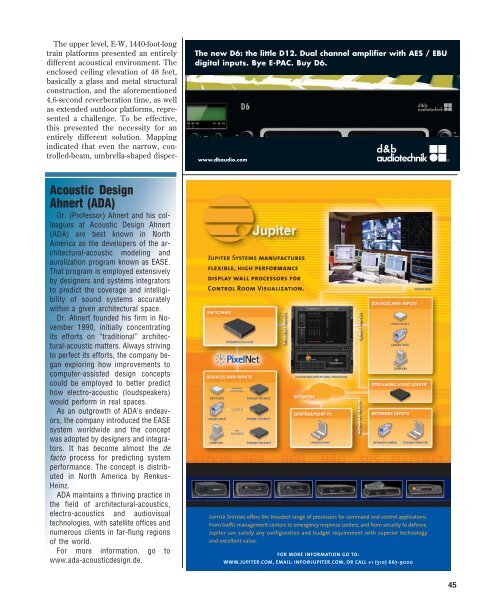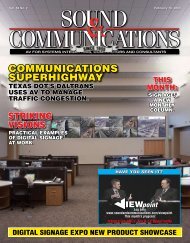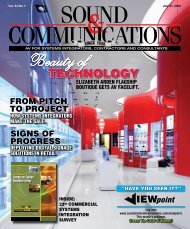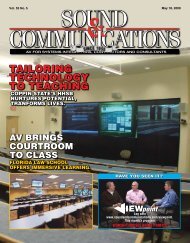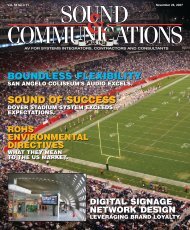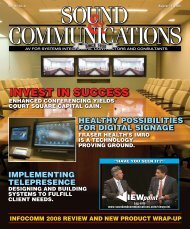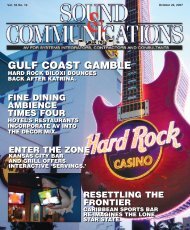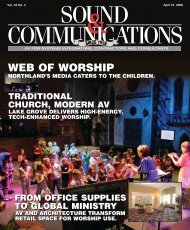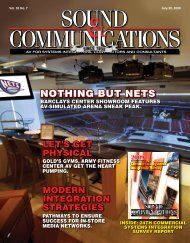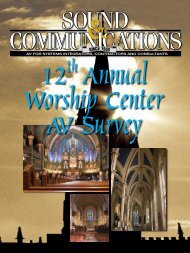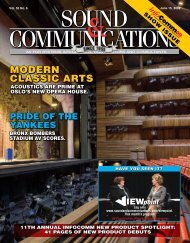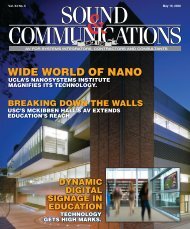Sound and Communications - February 2008 Issue
Sound and Communications - February 2008 Issue
Sound and Communications - February 2008 Issue
Create successful ePaper yourself
Turn your PDF publications into a flip-book with our unique Google optimized e-Paper software.
The upper level, E-W, 1440-foot-long<br />
train platforms presented an entirely<br />
different acoustical environment. The<br />
enclosed ceiling elevation of 48 feet,<br />
basically a glass <strong>and</strong> metal structural<br />
construction, <strong>and</strong> the aforementioned<br />
4.6-second reverberation time, as well<br />
as extended outdoor platforms, represented<br />
a challenge. To be effective,<br />
this presented the necessity for an<br />
entirely different solution. Mapping<br />
indicated that even the narrow, controlled-beam,<br />
umbrella-shaped disper-<br />
The new D6: the little D12. Dual channel amplifier with AES / EBU<br />
digital inputs. Bye E-PAC. Buy D6.<br />
www.dbaudio.com<br />
Acoustic Design<br />
Ahnert (ADA)<br />
Dr. (Professor) Ahnert <strong>and</strong> his colleagues<br />
at Acoustic Design Ahnert<br />
(ADA) are best known in North<br />
America as the developers of the architectural-acoustic<br />
modeling <strong>and</strong><br />
auralization program known as EASE.<br />
That program is employed extensively<br />
by designers <strong>and</strong> systems integrators<br />
to predict the coverage <strong>and</strong> intelligibility<br />
of sound systems accurately<br />
within a given architectural space.<br />
Dr. Ahnert founded his firm in November<br />
1990, initially concentrating<br />
its efforts on “traditional” architectural-acoustic<br />
matters. Always striving<br />
to perfect its efforts, the company began<br />
exploring how improvements to<br />
computer-assisted design concepts<br />
could be employed to better predict<br />
how electro-acoustic (loudspeakers)<br />
would perform in real spaces.<br />
As an outgrowth of ADA’s endeavors,<br />
the company introduced the EASE<br />
system worldwide <strong>and</strong> the concept<br />
was adopted by designers <strong>and</strong> integrators.<br />
It has become almost the de<br />
facto process for predicting system<br />
performance. The concept is distributed<br />
in North America by Renkus-<br />
Heinz.<br />
ADA maintains a thriving practice in<br />
the field of architectural-acoustics,<br />
electro-acoustics <strong>and</strong> audiovisual<br />
technologies, with satellite offices <strong>and</strong><br />
numerous clients in far-flung regions<br />
of the world.<br />
For more information, go to<br />
www.ada-acousticdesign.de.<br />
<br />
<br />
<br />
<br />
<br />
<br />
<br />
<br />
<br />
<br />
<br />
(continued on page 38)<br />
<strong>February</strong> <strong>2008</strong> 45


